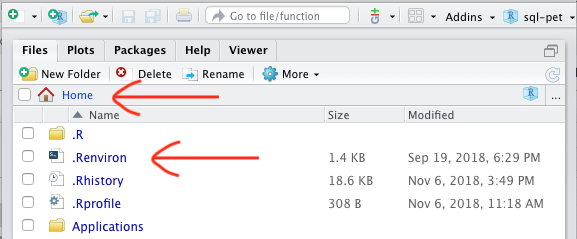Chapter 5 Securing and using your dbms log-in credentials
This chapter demonstrates how to:
- Keep necessary credentials secret or at least invisible
- Interact with PostgreSQL using your stored dbms credentials
Connecting to a dbms can be very frustrating at first. In many organizations, simply getting access credentials takes time and may involve jumping through multiple hoops. In addition, a dbms is terse or deliberately inscrutable when your credetials are incorrect. That’s a security strategy, not a limitation of your understanding or of your software. When R can’t log you on to a dbms, you usually will have no information as to what went wrong.
There are many different strategies for managing credentials. See Securing Credentials in RStudio’s Databases using R documentation for some alternatives to the method we adopt in this book. We provide more details about PostgreSQL Authentication in our sandbox environment in an appendix.
The following packages are used in this chapter:
library(tidyverse)
library(DBI)
library(RPostgres)
require(knitr)
library(sqlpetr)
library(connections)
sleep_default <- 3
theme_set(theme_light())5.1 Set up the adventureworks Docker container
5.1.1 Verify that Docker is running
Check that Docker is up and running:
## [1] "Docker is up but running no containers"5.1.2 Start the Docker container:
Start the adventureworks Docker container:
5.2 Storing your dbms credentials
In previous chapters the connection string for connecting to the dbms has used default credentials specified in plain text as follows:
user= 'postgres', password = 'postgres'
When we call sp_get_postgres_connection below we’ll use environment variables that R obtains from reading the .Renviron file when R starts up. This approach has two benefits: that file is not uploaded to GitHub and R looks for it in your default directory every time it loads. To see whether you have already created that file, use the R Studio Files tab to look at your home directory:

That file should contain lines that look like the example below. Although in this example it contains the PostgreSQL default values for the username and password, they are obviously not secret. But this approach demonstrates where you should put secrets that R needs while not risking accidental uploaded to GitHub or some other public location..
Open your .Renviron file with this command:
file.edit("~/.Renviron")
Or you can execute define_postgresql_params.R to create the file or you could copy / paste the following into your .Renviron file:
DEFAULT_POSTGRES_PASSWORD=postgres
DEFAULT_POSTGRES_USER_NAME=postgresOnce that file is created, restart R, and after that R reads it every time it comes up.
5.2.1 Connect with Postgres using the Sys.getenv function
Connect to the postgrSQL using the sp_get_postgres_connection function:
Sys.sleep(sleep_default)
# con <- connection_open( # use in an interactive session
con <- dbConnect( # use in other settings
RPostgres::Postgres(),
# without the previous and next lines, some functions fail with bigint data
# so change int64 to integer
bigint = "integer",
user = Sys.getenv("DEFAULT_POSTGRES_USER_NAME"),
password = Sys.getenv("DEFAULT_POSTGRES_PASSWORD"),
host = "localhost",
port = 5432,
dbname = "adventureworks")Once the connection object has been created, you can list all of the tables in one of the schemas:
## [1] 0## [1] "employee" "shift"
## [3] "employeepayhistory" "jobcandidate"
## [5] "department" "vemployee"
## [7] "vemployeedepartment" "vemployeedepartmenthistory"
## [9] "vjobcandidate" "vjobcandidateeducation"
## [11] "vjobcandidateemployment" "employeedepartmenthistory"